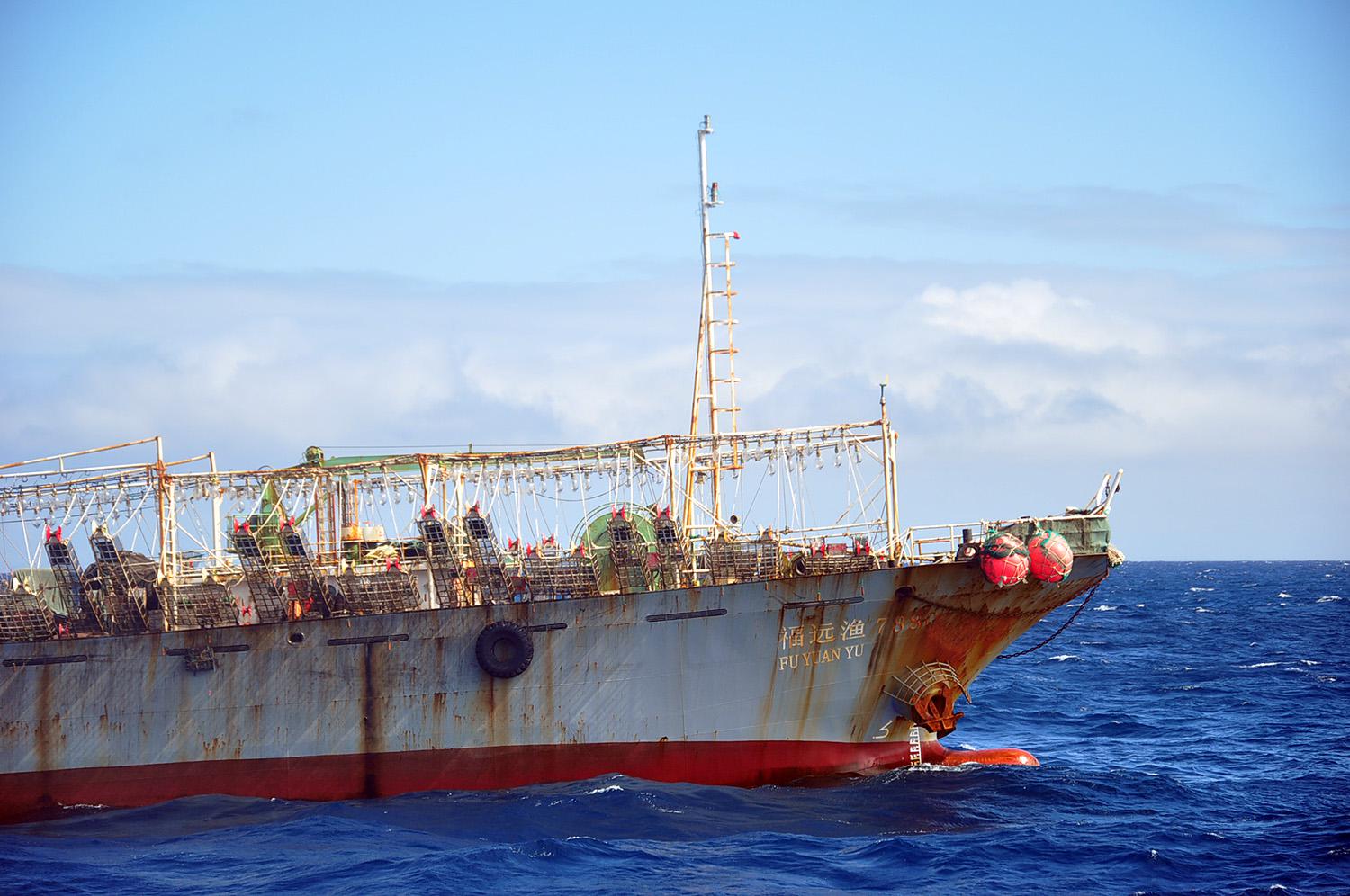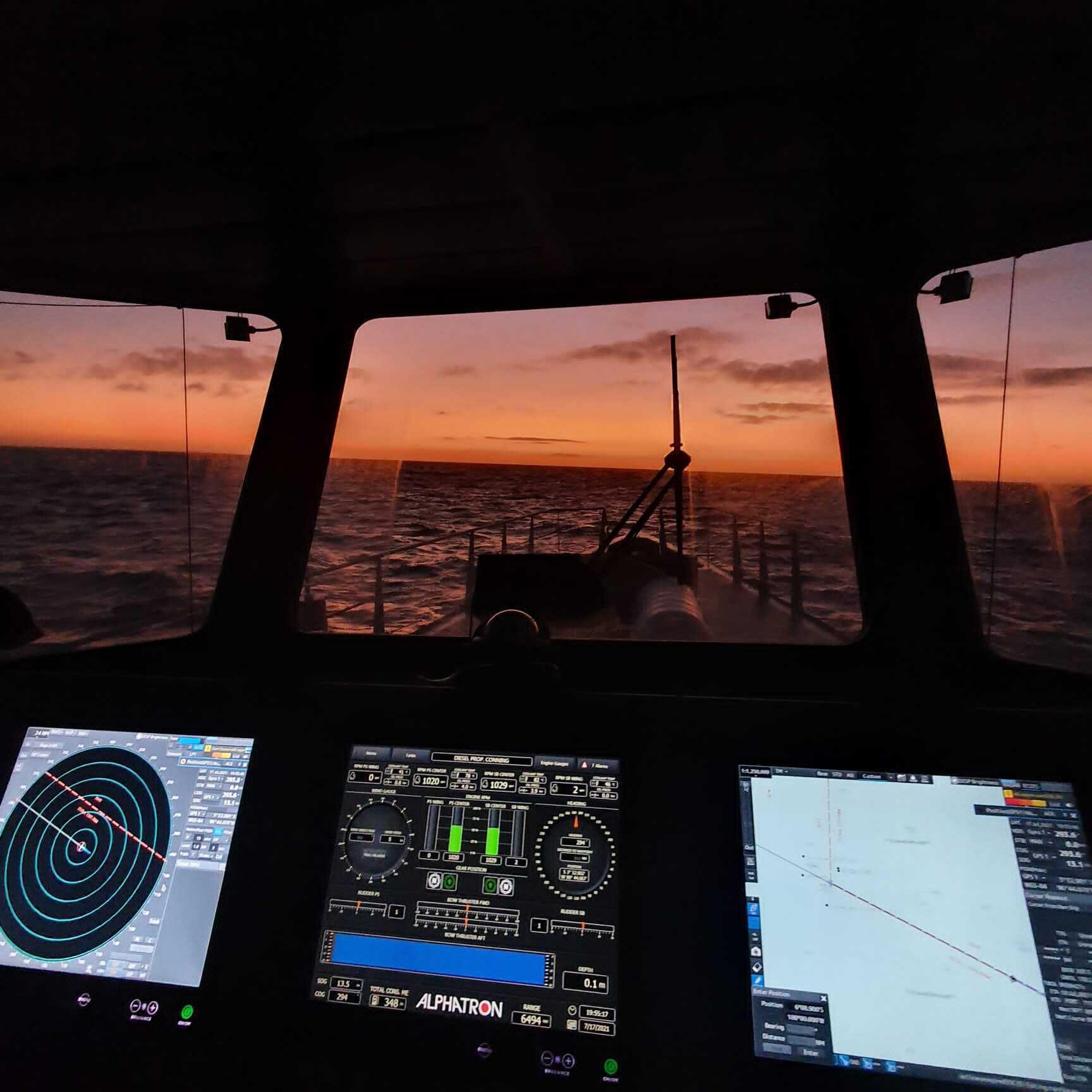Great Wall of Lights: China’s sea power on Darwin’s doorstep
ABOARD THE OCEAN WARRIOR in the eastern Pacific Ocean (AP) — It’s 3 a.m., and after five days plying through the high seas, the Ocean Warrior is surrounded by an atoll of blazing lights that overtakes the nighttime sky.
“Welcome to the party!” said third officer Filippo Marini as the spectacle floods the ship’s bridge and interrupts his overnight watch.
It’s the conservationists’ first glimpse of the world’s largest fishing fleet: an armada of nearly 300 Chinese vessels that have sailed halfway across the globe to lure the elusive Humboldt squid from the Pacific Ocean’s inky depths.
As Italian hip hop blares across the bridge, Marini furiously scribbles the electronic IDs of 37 fishing vessels that pop up as green triangles on the Ocean Warrior’s radar onto a sheet of paper, before they disappear.
Immediately he detects a number of red flags: two of the boats have gone ‘dark,’ their mandatory tracking device that gives a ship’s position switched off. Still others are broadcasting two different radio numbers — a sign of possible tampering.
The Associated Press with Spanish-language broadcaster Univision accompanied the Ocean Warrior this summer on an 18-day voyage to observe up close for the first time the Chinese distant water fishing fleet on the high seas off South America.
The vigilante patrol was prompted by an international outcry last summer when hundreds of Chinese vessels were discovered fishing for squid near the long-isolated Galapagos Islands, a UNESCO world heritage site that inspired 19th-century naturalist Charles Darwin and is home to some of the world’s most endangered species, from giant tortoises to hammerhead sharks.
China’s deployment to this remote expanse is no accident. Decades of overfishing have pushed its overseas fleet, the world’s largest, ever farther from home. Officially capped at 3,000 vessels, the fleet might actually consist of thousands more. Keeping such a sizable flotilla at sea, sometimes for years at a time, is at once a technical feat made possible through billions in state subsidies and a source of national pride akin to what the U.S. space program was for generations of Americans.
Beijing says it has zero tolerance for illegal fishing and points to recent actions such as a temporary moratorium on high seas squid fishing as evidence of its environmental stewardship. Those now criticizing China, including the U.S. and Europe, for decades raided the oceans themselves.
But the sheer size of the Chinese fleet and its recent arrival to the Americas has stirred fears that it could exhaust marine stocks. There’s also concern that in the absence of effective controls, illegal fishing will soar. The U.S. Coast Guard recently declared that illegal fishing had replaced piracy as its top maritime security threat.
Meanwhile, activists are seeking restrictions on fishing as part of negotiations underway on a first-ever High Seas Treaty, which could dramatically boost international cooperation on the traditionally lawless waters that comprise nearly half of the planet.
Of the 30 vessels the AP observed up close, 24 had a history of labor abuse accusations, past convictions for illegal fishing or showed signs of possibly violating maritime law. Collectively, these issues underscore how the open ocean around the Americas — where the U.S. has long dominated and China is jockeying for influence — have become a magnet for the seafood industry’s worst offenders.
Specifically, 16 ships either sailed with their mandatory safety transponders turned off, broadcast multiple electronic IDs or transmitted information that didn’t match its listed name or location — discrepancies that are often associated with illegal fishing, although the AP saw no evidence that they were engaged in illicit acitivity.
Six ships were owned by companies accused of forced labor including one vessel, the Chang Tai 802, whose Indonesian crew said they had been stuck at sea for years.
Another nine ships face accusations of illegal fishing elsewhere in the world while one giant fuel tanker servicing the fleet, the Ocean Ruby, is operated by the affiliate of a company suspected of selling fuel to North Korea in violation of United Nations sanctions. Yet another, the Fu Yuan Yu 7880, is operated by an affiliate of a Nasdaq-traded company, Pingtan Marine Enterprise, whose Chinese executives had their U.S. visas cancelled for alleged links to human trafficking.
“Beijing is exporting its overfishing problem to South America,” said Captain Peter Hammarstedt, director of campaigns for Sea Shepherd, a Netherlands-based ocean conservation group that operates nine well-equipped vessels, including the Ocean Warrior.
“China is chiefly responsible for the plunder of shark and tuna in Asia,” says Hammarstedt, who organized the high seas campaign, called Operation Distant Water, after watching how illegal Chinese vessels ravaged poor fishing villages in West Africa. “With that track record, are we really supposed to believe they will manage this new fishery responsibly?”
‘WILD WEST’
The roar of the mechanical jiggers pulling the catch from the ocean’s depths can be heard hundreds of feet away before you come upon the floating slaughterhouse. The stench too, as the highly aggressive squid blow their ink sacs in one final, futile effort to avoid their inexorable fate.
By all accounts, the Humboldt squid — named for the nutrient-rich current found off the southwest coast of South America — is one of the most abundant marine species. Some scientists believe their numbers may even be thriving as the oceans warm and their natural predators, sharks, and tuna, are fished out of existence.
But biologists say they’ve never faced a threat like the explosion of industrial Chinese fishing off South America.
The number of Chinese-flagged vessels in the south Pacific has surged 10-fold from 54 active vessels in 2009 to 557 in 2020, according to the South Pacific Regional Fisheries Management Organization, or SPRFMO, an inter-governmental group of 15 members charged with ensuring the conservation and sustainable fishing of the species. Meanwhile, the size of its catch has grown from 70,000 tons in 2009 to 358,000.
Fishing takes place almost exclusively at night when each ship turns on hundreds of lights as powerful as anything at a stadium to attract swarms of the fast-flying squid. The concentration of lights is so intense it can be seen from space on satellite images that show the massive fleet shining as brightly as major cities hundreds of miles away on land.
“It really is like the Wild West,” said Hammarstedt. “Nobody is responsible for enforcement out there.”
Experts warn that even a naturally bountiful species like squid is vulnerable to overfishing. Although it’s unknown how many Humboldt squid remain, they point to past disappearance of squid stocks in Argentina, Mexico, and Japan as cause for concern.
“If you have a vast resource and it’s easy to take, then it’s easy to fall into the trap of thinking that this is limitless, that it’s just stars in the sky,” said William Gilly, a Stanford University marine biologist. “If humanity puts its mind to it, there’s no limit to the damage we can do.”
Gilly said squid are also a key barometer of marine environments — a biological conveyor belt transporting energy from tiny carbon-absorbing plankton to longer-living predators, like sharks and tuna, and ultimately, human beings.
“The people who fish squid are happy,” said Daniel Pauly, a prominent marine biologist who in the 1990s coined the phrase “fishing down the food web” to describe how previously spurned chum were replacing bigger fish on dinner plates. “But this is part of the gradual degradation of the ocean.”
‘DARK’ FLEET
For dozens of Chinese ships, the journey to the warm equatorial waters near the Galapagos began months earlier, on the opposite side of South America, where every Austral summer, between November and March, hundreds of foreign-flagged jiggers scoop up untold amounts of shortfin squid in one of the world’s largest unregulated fishing grounds.
The plunderer’s paradise lies between Argentina’s maritime border and the British-held Falkland Islands in a Jamaica-sized no man’s land where fishing licenses, catch limits and oversight are non-existent.
Between November 2020 and May 2021, a total of 523 mostly Chinese fishing vessels — 35% more than the previous season — were detected just beyond the boundary of Argentina’s 200-nautical mile exclusive economic zone, according to satellite data analyzed by Windward, a maritime intelligence firm.
Of that amount, 42% had turned off at least once their safety transponders. Meanwhile, 188 of those same vessels showed up near the Galapagos, including 14 Chinese vessels that went offline in both oceans for an average 34 hours each time.
It’s impossible to know what the ships did while they were ‘dark.’ However, sometimes ships turn off their tracking systems to avoid detection while carrying out illicit activities. Argentine authorities over the years have spotted numerous Chinese vessels off the grid fishing illegally in its waters, once even firing shots into and sinking a trawler that tried to ram its pursuer near a whale breeding ground.
Under a United Nations maritime treaty, to which China is a signatory, large ships are required to continuously use what’s known as an automated identification system, or AIS, to avoid collisions. Switching it off, except in cases of an imminent threat, for example hiding from pirates, is a major breach that should lead to sanctions for a vessel and its owner under the law of the nation to which it is flagged.
But China until now appears to have done little to reign in its distant water fleet.
The Chinese fleet is able to fish for sometimes years at a time because they can offload their catch at sea into a network of giant refrigerated vessels, or reefers, capable of hauling more than 15,000 cubic meters of fish — enough to fill six Olympic-sized pools — to port. Giant tankers provide cheap fuel heavily subsidized by the Chinese government, adding to the environmental burden.
The 12 reefers active in the Pacific this past July as the Ocean Warrior was patrolling nearby had at least 196 encounters with fishing vessels during that period, according to satellite data analyzed by Global Fishing Watch, a group that supports sustainable fishing.
Nearly 11% of total U.S. seafood imports in 2019 worth $2.4 billion came from illegal, unreported and unregulated fishing, according to the U.S. International Trade Commission, a federal agency. Outside the U.S., the problem is believed to be even worse.
“We don’t know if things are getting better or worse,” said Boris Worm, a marine biologist at Dalhousie University in Halifax, Canada. “It basically comes down to who you believe.”
FISHY BUSINESS?
In the seascape of the world’s oceans, Pingtan Marine and its affiliates have left in their wake accusations of illegal fishing by authorities in places as diverse as South Africa, Timor Leste, Ecuador, and Indonesia.
But the company is not some rogue outfit. It boasts China’s second-largest overseas fleet, trades shares on the U.S. Nasdaq, and in its home port of Fuzhou, across from Taiwan, is helping build one of the world’s largest fish factories. The company’s Chairman and CEO, Zhou Xinrong, appears to have built the fishing empire through massive state loans, generous subsidies, and Communist Party connections.
“It’s not just a fishing company — it’s practically a Chinese government asset,” said Susi Pudjiastuti, who as Indonesia’s former fishing minister between 2014 and 2019 was lionized by conservationists for destroying hundreds of illegal foreign fishing vessels.
Fifty-seven of Pingtan’s ships, including three refrigerated carrier vessels, all of them owned directly or through an affiliate, were registered by China in the past few years to fish in the south Pacific, according to C4ADS, a Washington-based think tank that last year authored a report on illegal fishing.
Pingtan in its last earnings report almost a year ago said that it had $280 million in outstanding loans from the China Development Bank and other state lenders. One of the country’s biggest state investment funds owns an 8% stake in one of its subsidiaries. Meanwhile, Chinese state subsidies to Pingtan for the building of vessels totaled $29 million in the first nine months of last year — about a third of all its purchases of property and equipment.
As part of Pudjiastuti’s crackdown, vessels operated by two Pingtan affiliates in Indonesia had their licenses revoked for a slew of alleged offenses ranging from falsifying catch reports, illegal transshipments, and the smuggling of endangered species.
Those affiliates, PT Avona Mina Lestari and PT Dwikarya Reksa Abad, are managed or partly owned by members of Zhou’s immediate family, Pingtan disclosed in filings with the U.S. Securities and Exchange Commission.
Crew members of one vessel told authorities they had been “gang-beaten,” hit on their heads with a piece of steel and subjected to “torture” by their Chinese supervisors, according to an Indonesian court ruling upholding the ban on the Pingtan affiliate. A Panama-flagged carrier vessel, the Hai Fa, whose listed owner is a different Pingtan affiliate based in Hong Kong, was seized in 2014 with 900 tons of illegally caught fish, including endangered shark species. A lenient court later released the vessel from custody after it paid a $15,000 fine.
An entity majority-owned by Zhou’s wife also operates the Fu Yuan Yu Leng 999, which was caught in 2017 transiting through the Galapagos Marine Reserve with more than 6,000 dead sharks on board.
Another Pingtan-affiliated vessel spotted by AP, the Fu Yuan Yu 7880, was arrested by South Africa in 2016 after it tried to flee a naval patrol that suspected it of illegal squid fishing. The ship’s officers were found guilty of possessing illegal gear and disobeying a maritime authority but were released after paying a fine.
“The more you learn about these vessels and equipment, the harder it is to sleep at night,” said Pudjiastuti. “These South Americans should wake up as early as possible.”
Pingtan didn’t answer a detailed list of questions. “Pingtan doesn’t answer questions raised by the media,” the company said in an e-mail.
As scandal has followed Pingtan and its affiliates around the world, investors have dumped the company’s stock.
In June, Nasdaq sent notice that it would delist the company unless its share price, which has tumbled nearly 80% the last two years, crawls back above a minimum $1 threshold soon. The threat of delisting followed the abrupt resignation of the company’s independent auditor, which warned about Pingtan’s ability to continue doing business. Pingtan told the SEC that its failure to file any quarterly reports for nearly a year was due to a “material weakness” in its ability to conform with U.S. accounting practices.
One decision that Pingtan has also not commented on is the surprise U.S. sanction of its top executives. Two U.S. officials said that CEO Zhou Xinrong and his wife were among the 15 individuals who had their visas cancelled last year for being “complicit” in illegal fishing and human trafficking. The decision, taken in the waning days of the Trump administration, was the first of its kind specifically targeting abuse in the fishing industry, the two officials said on the condition of anonymity to discuss internal deliberations.
BULLYING CHINA?
Criticism of China’s distant water fishing fleet has spurred some reform.
Last year, China imposed stricter penalties on companies caught breaking the rules, including manipulating their transceivers. They’ve also boosted reporting requirements for transshipments on the high seas, banned blacklisted vessels from entering Chinese ports and ordered off-season moratoriums on squid fishing in the high seas near Argentina and Ecuador.
The measures, while far from a panacea, nonetheless mark a giant leap for the world’s largest consumer and producer of fish products.
“I used to go to conference and officials would be in just complete denial,” said Tabitha Mallory, a China scholar at the University of Washington who specializes in the country’s fishing policies. “At least now, they’re acknowledging that their fishing is unsustainable, even if it’s just to counter all the negative pushback they’re getting around the world.”
China’s Foreign Ministry, the Bureau of Fisheries and the China Overseas Fisheries Association, an industry group, didn’t respond to multiple requests for an interview nor a detailed list of questions.
China’s distant water fishing fleet launched in the 1980s as a response to depleting fish stocks at home and the need to feed its fast-growing population. But it’s evolved into a thriving industry and an important part of China’s geopolitical push to secure access to the world’s dwindling natural resources, says Mallory.
In the eastern city of Zhoushan, home to China’s largest distant water fleet, an ultramodern “Squid Museum” opened this year that allows visitors to follow the squid on a sanitized, adventure-filled 3D journey from the ocean depths to the giant jiggers and their eventual processing back at home into squid rings.
Researcher Pauly believes that much of the criticism of the Chinese fleet’s fishing around the Galapagos is attributed to growing anti-China sentiment in the U.S. and sensitivities about Beijing’s growing presence in what has traditionally been considered Washington’s backyard.
He said imposing restrictions on high seas fishing, something that could be discussed as part of the negotiations over a high seas treaty, would be a more effective way to curtail China’s activities than bullying.
“China doesn’t do anything that Europe has not done exactly the same way,” said Pauly. “The difference is that everything China does is big, so you see it.”
CHINA’S STONEWALLING
Seafood companies in the U.S. have started to take note of the risks posed by China’s expansion and are seeking to leverage their market power to bring more transparency to the sourcing of squid.
This year, a group of 16 importers and producers banded together to devise a common strategy to root out abuse. Much of their focus is on China, which is responsible for around half of the $314 million in squid that the U.S. imported in 2019, the bulk served up as fried calamari in restaurants
The initiative is opening something of a Pandora’s Box for an industry that until now has thrived in the shadows without a lot of attention focused on its supply chains. The bulk of China’s squid harvest comes from the high seas, where there’s little in the way of controls like there is in many coastal waters.
“Right now, it’s the perfect situation” for would-be violators, said Alfonso Miranda, executive director of CALAMASUR, a group made up of squid industry representatives from Mexico, Chile, Peru, and Ecuador. “You can do whatever you want, even forced labor, nobody says anything, and you still have a market for your product.”
One alternative is to deploy technology, like publicly available AIS tracking data, to allow consumers to eventually identify the very vessel — its owner, fishing history and precise location — that caught the fish. In that way, the seafood industry can catch up with other manufacturers, from meat producers to the garment trade, where such practices are more common.
“The keyword is traceability,” said Ambassador Jean Manes, the top civilian at U.S. Southern Command in Miami. “When consumers insist on traceability, the market responds.”
However, boosting transparency is a challenge the industry has grappled with for decades.
Nobody knows for sure how much China is fishing on the high seas. Meanwhile, critics say regional fishing management organizations that operate on the basis of consensus are powerless to block China from registering vessels with links to illegal fishing and abuse.
Case and point: the Hua Li 8, which was greenlighted by China to fish in the south Pacific in 2018 — two years after it was the target of an international manhunt when it fled warning shots fired by an Argentine naval vessel that had caught it fishing illegally. Four of the Hua Li 8’s crew members were treated like “slaves,” Indonesian officials said at the time of the ship’s arrest pursuant to an Interpol “Purple Notice.”
The ship again was involved in suspicious fishing activity in 2019, this time in the western hemisphere, when it went dark for 80 hours as it was fishing along the edge of Peru’s exclusive economic zone. At the same time as the ship was offline, vessel movements were detected inside Peru’s waters, nighttime satellite data analyzed by Global Fishing Watch shows.
Craig Loveridge, executive secretary of the SPRFMO, declined requests for interviews. But in an e-mail, he pointed out that it’s up to each member to take into account the history of fishing operators when deciding whether or not to authorize a vessel to fly its flag.
To address concerns, several South American governments proposed at this year’s SPRFMO meeting a number of conservation measures already in place elsewhere.
Ideas included banning transshipments at sea, allowing countries to board other member states’ vessels on the high seas, and creating a buffer zone so coastal states are automatically alerted whenever a foreign vessel comes within 12 nautical miles of its territorial waters.
But each proposal was shot down by China, Miranda said.
“China doesn’t really seem interested in expanding protection,” said Mallory. “They follow the letter of the law but not the spirit.”
Moreover, once the catch is landed in China — or a warehouse anywhere — it’s impossible to discern between legal and illegally caught fish.
“This is the black hole and having clarity there is really complex,” said Miranda. “There are many things that can be done but you need to rely on credible data, which right now is lacking.”
ALONE AT SEA
In the absence of more robust monitoring, the Ocean Warrior is something of a high seas’ sheriff holding bad actors responsible. But it’s surrounded by dozens of Chinese vessels accustomed to operating with little fear of reprisal.
As the sun prepares to set, and the Chinese squid fleet awakens in time for another night of fishing, the Ocean Warrior’s crew sets out on a dinghy to inspect up close the Chang Tai 802. The ship is one of 39 vessels suspected of forced labor in a May 2021 report by Greenpeace based on complaints by workers to Indonesian authorities.
Six shirtless men, all of them Indonesian, gather on the Chang Tai’s stern, gesturing friendlily and looking comforted to see another human being so far from land.
But the mood quickly turns when one man, who the AP isn’t identifying by name out of concern for his safety, shouts above the engine that his boss is “not nice” and asks, with only the foggiest of comprehension, whether the coronavirus pandemic that has ravaged the world has arrived in the U.S.
“I’m stuck here,” he says with a sullen look before a visibly irritated Chinese supervisor appears and orders the men back to work. “I want to go home.”
A day later, when the Ocean Warrior returns with a megaphone to facilitate the open water exchange, the Chinese supervisor moves quickly to block any talk with the English-speaking strangers. But as the Chang Tai pulls away, the man throws overboard a plastic bottle stuffed with his brother’s phone number scribbled on a piece of paper.
Reached back home in Indonesia, the relative confesses to knowing precious little about how his brother was recruited or the conditions of his employment. Since leaving home three years ago, after graduating from a vocational school with few other job prospects, he’s communicated with his family only sporadically.
He nonetheless worries for his brother’s wellbeing, to the point that he recently pressed the agency that hired him to bring him back. The Greenpeace report cites a complaint by another anonymous Indonesian sailor on the same ship who, while ill with kidney pain due to drinking poorly treated seawater, was forced to sign a document or risk being marooned in Peru with no travel documents.
“I hope he can come back soon,” says the man’s brother, hesitant to reveal too much out of fear it could compromise someone’s safety. “And I hope he’s always healthy.”
—
AP Writer Joe McDonald and AP researcher Yu Bing in Beijing, AP Global Investigations intern Roselyn Romero in San Luis Obispo, Calif., and AP Writers Edna Tarigan and Nini Karmini in Jakarta, Indonesia, contributed to this report.
Follow Goodman on Twitter: @APJoshGoodman
Contact AP’s global investigative team at Investigative@ap.org or https://www.ap.org/tips/





























